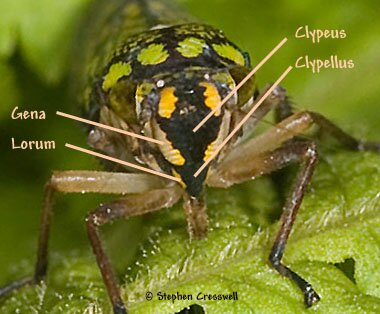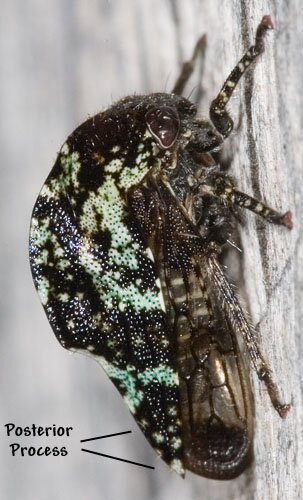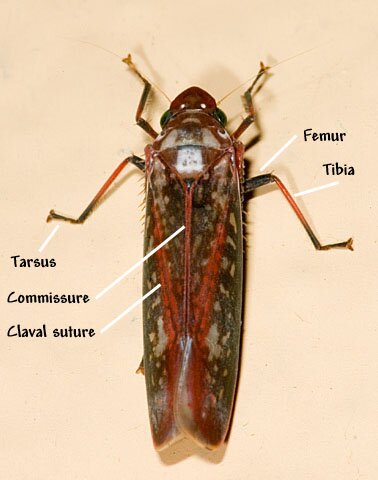
Aedeagus. The phallus of the male (an internal feature of the abdomen), often used in identification.
Antennal disk. Flat, round structure present on the antennae of Idiocerus, a Leafhopper genus.
Apex. The portion of a body part that is farthest of the central body or from the base. The apex of an antenna is the tip. The apex of the pronotum is the part nearest the head. The apex of the abdomen is the posterior (rearmost) portion. The plural of apex is apices. The opposite of apex is base.
Appendix. A section of the outer edge of the forewing, typically long and narrow and without markings.
Apical. Pertaining to the apex.
Apical cells. Wing cells farthest from the wing's point of attachment.
Basal. Pertaining to the base.
Base. The portion of a body part that is closest to the central body and farthest from the apex. For example, the base of an antenna is the part nearest the head. The opposite of base is apex.
Beak. The piercing-sucking mouthparts found in Hemiptera.
Brochosomes. A waxy substance secreted by leafhoppers, which is spread over the body using the legs, or spread over the eggs. Brochosomes are believed to offer protection from desiccation, parasites, fungi, and sticky substances such as the leafhoppers excretions.
Clavus. Part of the forewing; see illustration just below.
Claval suture. The line formed by the meeting of the Clavus and the Corium. See illustration just below.

Clypeus. The large, upper body plate on the front surface of the head, viewed "face-on." See illustration below.
Clypellus. The smaller, lower body plate on the front surface of the head, viewed "face-on." See illustration below.
Commissure. The straight, central line seen in a dorsal view of the folded wings: the edge where the forewings meet. See illustration at the bottom of this page.
Congener. Said of a species that is in the same genus as the species at hand.
Corium. Part of the forewing; see illustration above.
Costal margin. The anterior edge of the hind wing.
Crown. See Vertex.
Discal cells. Wings cells that are near the center of the wing and that do not reach a wing margin.
Diurnal. Active during the day; the opposite of diurnal is nocturnal.
Dorsal. Pertaining to the dorsum.
Dorsum. The "back" of the insect. Typically the dorsum is seen in a birds eye view of the insect.
Edges. The side margins of a structure, such as the forewing.
Face. The head's cephalic aspect, including the Front.
Femur. The first elongate leg segment. Moving apically, the femur is attached to the tibia which is then attached to the tarsi. The plural of femur is femora.
Flagellum. The whip-like, apical segment of the antenna; the antenna also has two basal segments.
Front. The Clypeus and Clypellus.
Gena. The maxillary plate; see illustration.
Instar. A period in the life of a nymph, either between hatching and the first molt, or between two molts.
Longitudinal. Going in the "length" direction on the leafhopper as opposed to the "width" direction. For example, the commissure is longitudinal. The opposite of longitudinal is transverse.
Lorum. The mandibular plate; see illustration.
Margins. Same as edges; the sides of structures such as the forewings.
Mesonotum. The anterior part of what is commonly called the scutellum. When the word mesonotum is used, it refers to the part in front of the scutellar suture, while the part to the rear of this suture is called the scutellum. But be aware that both parts combined are often referred to as the scutellum.
Oblique. At an angle; neither horizontal nor vertical; diagonal.
Ocelli, singular ocellus. Simple eyes. Much smaller than the pair of compound eyes. Their number and location is used in some keys to family and subfamily in Auchenorrhyncha.
Ocellocular area. The area between a compound eye and the nearby ocellus.
Ocellocular ledge. A carina (raised ridge) in the Ocellocular area, present in some groups.
Posterior process. A slender part at the rear of the hopper, such as the "panhandle" at the rear of a number of Treehopper species. See illustration below.
 Pronotal process. A "horn" or other protuberance of the pronotum such as those found in Treehoppers.
Pronotal process. A "horn" or other protuberance of the pronotum such as those found in Treehoppers.
Pronotum. The large dorsal plate between the head and the scutellum.
Reticulate. Forming a net-like pattern. For example, a pattern of veins and cross-veins that form numerous rectangles is said to be reticulate.
Scape. The basal segment of the antennae.
Scutellum. The often-triangular dorsal plate behind the pronotum and in front of the wings. See also the entry for Mesonotum.
Scutellar suture. A small line, typically near the center of the Scutellum.
Setae. Bristles, stiffened hairs. The singular of setae is seta. Counts of setae on the legs, or of rows of setae, are often used in keys in the Auchenorrhyncha.
Setose. Bearing setae.
Sinuate. Said of a line or an edge that is wavy.
Sternum VII. A ventral plate of the female, the shape of which is sometimes used for identification, particularly of genera.
Striae. Longitudinal lines on a homopteran.
Striate. With striae present.
Striations. Same as striae.
Styles. Structures on the male that are used for clasping the female during mating. The shape of the styles is sometimes used to identify various groups.
Tarsus. The apcial section of the leg; the "foot." At its basal end the tarsus is attached to the tibia. The plural of tarsus is tarsi.
Tegmen. The front wings, which hide the folded rear wings when the insect is at rest. This term is used in insect groups (including Auchenorrhyncha) that have the front wings thick and leathery. The plural of tegmen is tegmina.
Teneral. An adult insect that has recently molted, and is typically soft and light-colored and not yet capable of flight.

Tibia. The shin; the middle section of the leg located between the femur and the tarsus. At its basal end the tibia is attached to the femur; at its apical end the tibia is attached to the tarsus. The plural of tibia is tibiae.
Transocular width. The space on the dorsum of the head between the two compound eyes.
Transverse. Going in the "width" direction on the insect as opposed to the "length" direction. For example, the base of the pronotum runs in a transverse direction. The opposite of transverse is longitudinal.
Tymbals. Abdominal sound-producing organs.